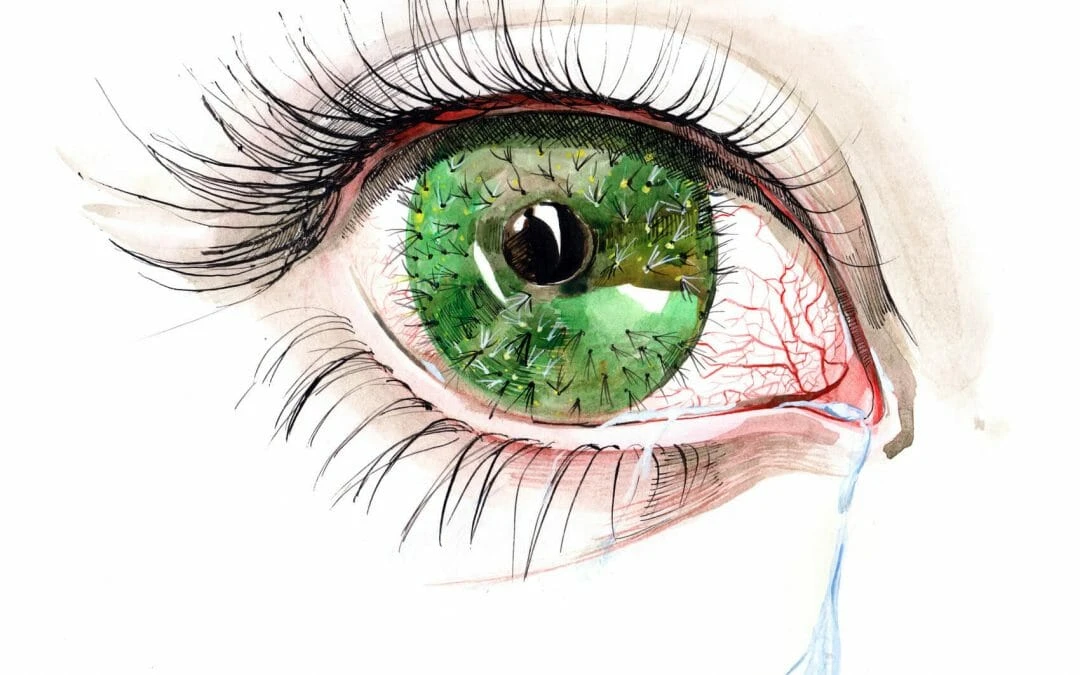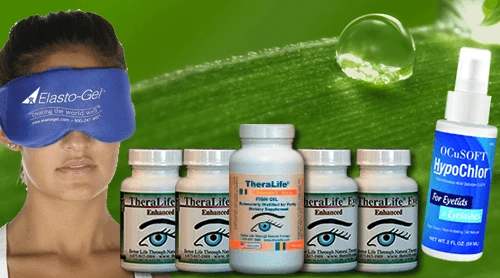Various reasons can cause red Irritated Eyes; red eyes can happen at any time.
There are many reasons that red, irritated eyes occur:
- Chronic dry eyes
- Autoimmune dry eyes – Sjogren’s Syndrome, Lupus, Rheumatoid Arthritis, and more.
- Air Quality– pollution causes red eyes
- Eye Surgery and Medications
- Lifestyle and Habits
- Being Female – hormone changes
Eye Conditions that cause red irritated dry eyes
- Chronic dry eyes – very often, dry eyes result in irritated, red eyes.
- Conjunctivitis – The most common cause, conjunctivitis, causes the eyes’ whites to become pink or red.
- Ocular Herpes – Caused by the type 1 herpes simplex virus, ocular herpes causes lesions on the eyes resulting in inflammation and scarring of the cornea.
- Ocular Rosacea – A reddening of the whites of the eyes. People with facial rosacea almost always have ocular rosacea. Ocular rosacea mainly affects people between 30 and 60 years of age. Those with fair skin and light-colored hair and eyes and women in menopause tend to develop ocular rosacea.
- Iritis – Anterior uveitis (Iritis) is an inflammation of the iris where small white blood cells from the affected area along with excess protein float inside the fluid that sits between the iris and the cornea.
- Eye Chalazion or Styes – caused by inflammation or infection of an eyelash follicle or a meibomian gland located along the eyelid edge. Chalazion or stye are presented as a red, painful lump. For a stye, these “pimple-like” areas are contagious. A chalazion is similar but not contagious. Clogged Meibomian glands cause both due to dry eyes.
Environmental Factors
Allergies. Seasonal and food allergies, climate, and smoking can cause eyes to become red and irritated. Thirty to forty percent (30-40%) of Americans have seasonal or food allergies. Exposure to smoke, whether from a smoker or burning material, develops red, irritated eyes.
- Allergies and Sensitivities – Whether seasonal or chronic, allergy sufferers and those sensitivities to specific issues such as rheumatoid arthritis or even depression can develop red eyes. Eighty percent of people with allergies develop eye allergies and red, irritated eyes.
- Weather – Windy, dry environmental conditions can dry out the fluid layer that protects the eyes.
- A dry climate can also cause red eyes to worsen and more irritation.
- Smoking is not only bad for a person’s health; smoking can worsen dry, red, irritated eyes. Avoiding smoke can help, but it may not be avoidable if the smoke is in the environment.
Eye Surgery and Medication
LASIK Eye Surgery
LASIK surgery is popular for those wanting better vision. However, LASIK eye surgery can damage nerve fibers or disrupt the tear film leading to dry eyes.
Medications leading to red irritated eyes.
Certain drugs such as antihistamines, sleeping pills, and anti-anxiety medications can restrict blood flow to the eyes, making them irritated and red.
Lifestyle Habits
Computer Overuse
Excessive computer or mobile phone usage can cause one to blink less, which leads to dry eyes. Eye strain from extended computer usage is also a common problem for red, irritated eyes.
Fatigue causing red, irritated eyes.
Fatigue from computer use can leave the eyes sore and irritated. Rest your eyes 5 minutes every hour, and limit electronic usage within an hour before bedtime.
Gender
Hormones affect dry eyes.
Women present particular menopause, menstrual cycles, and pregnancy that can cause red, irritated eyes and dry eye symptoms.
- Menopause: Lowered estrogen levels can lead to worsening dry eye symptoms.
- Menstrual Cycle: Higher estrogen levels during the first menstrual cycle can worsen red and dry eye symptoms.
- Pregnancy: Changing hormones occurring during pregnancy can also worsen dry and red eye symptoms.
The TheraLife solution for red, irritated, dry eyes
TheraLife is a leader in chronic dry eye relief. TheraLife goes directly to the source of the problem of red, irritated, dry eyes. TheraLife is the natural dry eye relief solution. TheraLife addresses the fundamental cause of dry eyes: underactive tear production. We are targeting the issue from the inside out orally. TheraLife provides natural dry eye relief by balancing the body’s healing tears.
How does TheraLife work?
TheraLife aids the body in natural tear production and ends reliance on eye drops. Frequent eye drops use can contribute to chronic dry eyes.
By ending the reliance on eye drops, we restore comfortable vision naturally. Stop wasting time on treatments that fail to address the root cause of dry eye problems. Try TheraLife today for a natural solution to dry eyes.
Take action today
Call and talk to a doctor toll-free 1-877-917-1989
US/Canada. International call (650) 949-6080. Send email inquiries to :
References
- E A. Lemp, C. Baudouin, J. Baum et al., “The definition and classification of dry eye disease: report of the definition and classification subcommittee of the international Dry Eye WorkShop,” Ocular Surface, vol. 5, no. 2, pp. 75–92, 2007.View at:
- Delaleu, R. Jonsson, and M. M. Koller, “Sjögren’s syndrome,” European Journal of Oral Sciences, vol. 113, no. 2, pp. 101–113, 2005.View at:
- “Methodologies to diagnose and monitor dry eye disease: report of the diagnostic methodology subcommittee of the international dry eye workshop (2007),” The Ocular Surface, vol. 5, no. 2, pp. 108–152, 2007.View at:
- Uchino, Y. Uchino, M. Dogru et al., “Dry eye disease and work productivity loss in visual display users: the Osaka study,” The American Journal of Ophthalmology, vol. 157, no. 2, pp. 294–300, 2014.View at:
- R. Grubbs Jr., S. Tolleson-Rinehart, K. Huynh, and R. M. Davis, “A review of quality of life measures in dry eye questionnaires,” Cornea, vol. 33, no. 2, pp. 215–218, 2014.View at:
- J. Paulsen, K. J. Cruickshanks, M. E. Fischer et al., “Dry eye in the beaver dam offspring study: prevalence, risk factors, and health-related quality of life,” American Journal of Ophthalmology, vol. 157, no. 4, pp. 799–806, 2014.View at:
- Miljanović, R. Dana, D. A. Sullivan, and D. A. Schaumberg, “Impact of dry eye syndrome on vision-related quality of life,” American Journal of Ophthalmology, vol. 143, no. 3, pp. 409.e2–415.e2, 2007.View at:
- Tong, S. Waduthantri, T. Y. Wong et al., “Impact of symptomatic dry eye on vision-related daily activities: the Singapore malay eye study,” Eye, vol. 24, no. 9, pp. 1486–1491, 2010.View at:
- A. Schaumberg, R. Dana, J. E. Buring, and D. A. Sullivan, “Prevalence of dry eye disease among US men: estimates from the physicians’ health studies,” Archives of Ophthalmology, vol. 127, no. 6, pp. 763–768, 2009.View at:
- Sharma and H. B. Hindman, “Aging: a predisposition to dry eyes,” Journal of Ophthalmology, vol. 2014, Article ID 781683, 8 pages, 2014.View at:
- E. Moss, R. Klein, and B. E. K. Klein, “Prevalance of and risk factors for dry eye syndrome,” Archives of Ophthalmology, vol. 118, no. 9, pp. 1264–1268, 2000.View at:
- C. Pflugfelder, “Prevalence, burden, and pharmacoeconomics of dry eye disease,” The American Journal of Managed Care, vol. 14, no. 3, supplement, pp. S102–S106, 2008.
- D. Schein, B. Munuz, J. M. Tielsch, K. Bandeen-Roche, and S. West, “Prevalence of dry eye among the elderly,” The American Journal of Ophthalmology, vol. 124, no. 6, pp. 723–728, 1997.
- A. Smith, J. Albenz, C. Begley et al., “The epidemiology of dry eye disease: report of the epidemiology subcommittee of the international Dry Eye WorkShop (2007),” Ocular Surface, vol. 5, no. 2, pp. 93–107, 2007.
- A. Lemp, “Advances in understanding and managing dry eye disease,” The American Journal of Ophthalmology, vol. 146, no. 3, pp. 350.e1–356.e1, 2008.View at:
- A. Schaumberg, D. A. Sullivan, and M. R. Dana, “Epidemiology of dry eye syndrome,” Advances in Experimental Medicine and Biology, vol. 506, pp. 989–998, 2002.
- A. Schaumberg, J. E. Buring, D. A. Sullivan, and M. Reza Dana, “Hormone replacement therapy and dry eye syndrome,” The Journal of the American Medical Association, vol. 286, no. 17, pp. 2114–2119, 2001.
- S. Kassan and H. M. Moutsopoulos, “Clinical manifestations and early diagnosis of Sjögren syndrome,” Archives of Internal Medicine, vol. 164, no. 12, pp. 1275–1284, 2004.
- Fujita, T. Igarashi, T. Kurai, M. Sakane, S. Yoshino, and H. Takahashi, “Correlation between dry eye and rheumatoid arthritis activity,” The American Journal of Ophthalmology, vol. 140, no. 5, pp. 808–813, 2005.
- C. Sacca, A. Poscotto, G. M. Venturino et al., “Prevalence and treatment of Helicobacter pyloriin patients with blepharitis,” Investigative Ophthalmology & Visual Science, vol. 47, pp. 501–508, 2006.
- Blehm, S. Vishnu, A. Khattak, S. Mitra, and R. W. Yee, “Computer vision syndrome: a review,” Survey of Ophthalmology, vol. 50, no. 3, pp. 253–262, 2005.
- C. Lang and R. E. Roehrs, “Ophthalmic preparations,” in Remington: The Science and Practice of Pharmacy, D. B. Troy, Ed., vol. 1, pp. 850–854, Lippincott Williaims Wilkins, Philadelphia, Pa, USA, 21st edition, 2005.
- Lakshmi Prabha, “Tear secretion—a short review,” Journal of Pharmaceutical Sciences and Research, vol. 6, no. 3, pp. 155–157, 2014.
- Peters and K. Colby, “The tear film,” in Foundation Volume 2: Physiology of the Eye and Visual System, W. Tasman and E. A. Jaeger, Eds., Duane’s Foundations of Clinical Ophthalmology, Lippincott Williams & Wilkins, Philadelphia, Pa, USA, 2006, Duanes Ophthalmology on CD rom.
- A. Lemp, “Report of the national eye institute/industry workshop on clinical trials in dry eyes,” CLAO Journal, vol. 21, no. 4, pp. 221–232, 1995.
- Agarwal, A. Agarwal, D. J. Apple, L. Buratto, and J. L. Alió, “Tear film physiology,” in Textbook of Ophthalmology: Basic Sciences Optics and Refraction Neuro-Ophthalmology Strabismus, J. P. Vij, Ed., vol. 1, pp. 39–45, Jaypee Brothers Medical Publishers, New Delhi, India, 1st edition, 2002.
- P. Craig and A. Tomlinson, “Importance of the lipid layer in human tear film stability and evaporation,” Optometry and Vision Science, vol. 74, no. 1, pp. 8–13, 1997.
- P. McCulley and W. E. Shine, “The lipid layer of tears: dependent on meibomian gland function,” Experimental Eye Research, vol. 78, no. 3, pp. 361–365, 2004.
- M. Tabery, “The mucus in the preocular tear film,” in Keratoconjunctivitis Sicca and Filamentary Keratopathy: In Vivo Morphology in the Human Cornea and Conjunctiva, H. M. Tabery, Ed., pp. 1–14, Springer, Berlin, Germany, 2012.
- M. Tiffany, “Tears in health and disease,” Eye, vol. 17, no. 8, pp. 923–926, 2003.
- E. Johnson and P. J. Murphy, “Changes in the tear film and ocular surface from dry eye syndrome,” Progress in Retinal and Eye Research, vol. 23, no. 4, pp. 449–474, 2004.
- Tsuji and K. Kawazu, “Biomarker identification of tear fluid,” Metabolomics, vol. 2, article 105, 2012.
- A. Mengi and S. G. Deshpande, “Ocular drug delivery,” in Controlled and Novel Drug Delivery, N. K. Jain, Ed., pp. 82–90, CBS Publishers and Distributors, New Delhi, India, 1997.
- Snyder and R. J. Fullard, “Clinical profiles of non dry eye patients and correlations with tear protein levels,” International Ophthalmology, vol. 15, no. 6, pp. 383–389, 1991.
- E. Stern, J. Gao, K. F. Siemasko, R. W. Beuerman, and S. C. Pflugfelder, “The role of the lacrimal functional unit in the pathophysiology of dry eye,” Experimental Eye Research, vol. 78, no. 3, pp. 409–416, 2004.
- E. Stern and S. C. Pflugfelder, “Inflammation in dry eye,” Ocular Surface, vol. 2, no. 2, pp. 124–130, 2004.
- I. Prydal, P. Artal, H. Woon, and F. W. Campbell, “Study of human precorneal tear film thickness and structure using laser interferometry,” Investigative Ophthalmology & Visual Science, vol. 33, no. 6, pp. 2006–2011, 1992.
- Y. Niederkorn and H. J. Kaplan, “Immune response and the eye,” Chemical Immunology and Allergy, vol. 92, pp. 176–184, 2007.
- Y. Niederkorn, “Regulatory T cells and the eye,” Chemical Immunology and Allergy, vol. 92, pp. 131–139, 2007.
- J. Driver and M. A. Lemp, “Meibomian gland dysfunction,” Survey of Ophthalmology, vol. 40, no. 5, pp. 343–367, 1996
- Guzey, I. Ozardali, E. Basar, G. Aslan, A. Satici, and S. Karadede, “A survey of trachoma: the histopathology and the mechanism of progressive cicatrization of eyelid tissues,” Ophthalmologica, vol. 214, no. 4, pp. 277–284, 2000.
- W. Yee, H. G. Sperling, A. Kattek et al., “Isolation of the ocular surface to treat dysfunctional tear syndrome associated with computer use,” Ocular Surface, vol. 5, no. 4, pp. 308–315, 2007.
- Versura, P. Nanni, A. Bavelloni et al., “Tear proteomics in evaporative dry eye disease,” Eye, vol. 24, no. 8, pp. 1396–1402, 2010.
- D. Wagh and D. U. Apar, “Cyclosporine a loaded PLGA nanoparticles for dry eye disease: in vitrocharacterization studies,” Journal of Nanotechnology, vol. 2014, Article ID 683153, 10 pages, 2014.
- E. Shine and J. P. McCulley, “Keratoconjunctivitis sicca associated with meibomian secretion polar lipid abnormality,” Archives of Ophthalmology, vol. 116, no. 7, pp. 849–852, 1998.
- N. Foulks, K. K. Nichols, A. J. Bron, E. J. Holland, M. B. McDonald, and J. Daniel Nelson, “Improving awareness, identification, and management of meibomian gland dysfunction,” Ophthalmology, vol. 119, no. 10, supplement, pp. S1–S12, 2012.
- Ohashi, R. Ishida, T. Kojima et al., “Abnormal protein profiles in tears with dry eye syndrome,” The American Journal of Ophthalmology, vol. 136, no. 2, pp. 291–299, 2003.
- Solomon, D. Dursun, Z. Liu, Y. Xie, A. Macri, and S. C. Pflugfelder, “Pro- and anti-inflammatory forms of interleukin-1 in the tear fluid and conjunctiva of patients with dry-eye disease,” Investigative Ophthalmology and Visual Science, vol. 42, no. 10, pp. 2283–2292, 2001.
- Kaercher and A. Bron, “Classification and diagnosis of dry eye,” in Surgery for the Dry Eye, G. Geerling and H. Brewitt, Eds., vol. 41 of Developments in Ophthalmology, pp. 36–53, 2008.
- Murube, J. Németh, H. Höh et al., “The triple classification of dry eye for practical clinical use,” European Journal of Ophthalmology, vol. 15, no. 6, pp. 660–667, 2005.
- C. Pflugfelder, S. C. G. Tseng, O. Sanabria et al., “Evaluation of subjective assessments and objective diagnostic tests for diagnosing tear-film disorders known to cause ocular irritation,” Cornea, vol. 17, no. 1, pp. 38–56, 1998.
- Yokoi and A. Komuro, “Non-invasive methods of assessing the tear film,” Experimental Eye Research, vol. 78, no. 3, pp. 399–407, 2004.
- J. Bron, “Diagnosis of dry eye,” Survey of Ophthalmology, vol. 45, supplement 2, pp. S221–S226, 2001.
- Petroutsos, C. A. Paschides, K. X. Karakostas, and K. Psilas, “Diagnostic tests for dry eye disease in normals and dry eye patients with and without Sjogren’s syndrome,” Ophthalmic Research, vol. 24, no. 6, pp. 326–331, 1992.
- Rosenfield, “Computer vision syndrome: a review of ocular causes and potential treatments,” Ophthalmic and Physiological Optics, vol. 31, no. 5, pp. 502–515, 2011.
- B. Abelson, G. W. Ousler III, L. A. Nally, D. Welch, and K. Krenzer, “Alternative reference values for tear film break up time in normal and dry eye populations,” Advances in Experimental Medicine and Biology, vol. 506, pp. 1121–1125, 2002.
- S. Mengher, A. J. Bron, S. R. Tonge, and D. J. Gilbert, “A non-invasive instrument for clinical assessment of the pre-corneal tear film stability,” Current Eye Research, vol. 4, no. 1, pp. 1–7, 1985.
- J. Bron, V. E. Evans, and J. A. Smith, “Grading of corneal and conjunctival staining in the context of other dry eye tests,” Cornea, vol. 22, no. 7, pp. 640–650, 2003.
- Watanabe and M. Tanaka, “Rose bengal staining and expression of mucin-like glycoprotein in cornea epithelium,” Investigative Ophthalmology & Visual Science, vol. 37, p. S357, 1996.
- J. Kim and G. N. Foulks, “Evaluation of the effect of lissamine green and rose bengal on human corneal epithelial cells,” Cornea, vol. 18, no. 3, pp. 328–332, 1999.
- C. Pflugfelder, A. Solomon, and M. E. Stern, “The diagnosis and management of dry eye: a twenty-five-year review,” Cornea, vol. 19, no. 5, pp. 644–649, 2000.
- A. Afonso, D. Monroy, M. E. Stern, W. J. Feuer, S. C. G. Tseng, and S. C. Pflugfelder, “Correlation of tear fluorescein clearance and Schirmer test scores with ocular irritation symptoms,” Ophthalmology, vol. 106, no. 4, pp. 803–810, 1999.
- Tsubota, M. Kaido, Y. Yagi, T. Fujihara, and S. Shimmura, “Diseases associated with ocular surface abnormalities: the importance of reflex tearing,” British Journal of Ophthalmology, vol. 83, no. 1, pp. 89–91, 1999.
- -A. Javadi and S. Feizi, “Dry eye syndrome,” Journal of Ophthalmic and Vision Research, vol. 6, no. 3, pp. 192–198, 2011.View at: Google Scholar
- J. Mackor and O. P. van Bijsterveld, “Tear function parameters in Keratoconjunctivitis sicca with and without the association of Sjogren’s syndrome,” Ophthalmologica, vol. 196, no. 4, pp. 169–174, 1988.
- A. Lemp, A. J. Bron, C. Baudouin et al., “Tear osmolarity in the diagnosis and management of dry eye disease,” The American Journal of Ophthalmology, vol. 151, no. 5, pp. 792–798, 2011.
- Rolando, F. Terragna, G. Giordano, and G. Calabria, “Conjunctival surface damage distribution in keratoconjunctivitis sicca. An impression cytology study,” Ophthalmologica, vol. 200, no. 4, pp. 170–176, 1990.
- Calonge, Y. Diebold, V. Sáez et al., “Impression cytology of the ocular surface: a review,” Experimental Eye Research, vol. 78, no. 3, pp. 457–472, 2004
- G. Begley, B. Caffery, R. L. Chalmers, and G. L. Mitchell, “Use of the dry eye questionnaire to measure symptoms of ocular irritation in patients with aqueous tear deficient dry eye,” Cornea, vol. 21, no. 7, pp. 664–670, 2002.
- D. Schein, J. M. Tielsch, B. Munoz, K. Bandeen-Roche, and S. West, “Relation between signs and symptoms of dry eye in the elderly: a population-based perspective,” Ophthalmology, vol. 104, no. 9, pp. 1395–1401, 1997
- M. Schiffman, M. D. Christianson, G. Jacobsen, J. D. Hirsch, and B. L. Reis, “Reliability and validity of the ocular surface disease index,” Archives of Ophthalmology, vol. 118, no. 5, pp. 615–621, 2000.
- Sahai and P. Malik, “Dry eye: prevalence and attributable risk factors in a hospital-based population,” Indian Journal of Ophthalmology, vol. 53, no. 2, pp. 87–91, 2005.
- D. Perry and E. D. Donnenfeld, “Dry eye diagnosis and management in 2004,” Current Opinion in Ophthalmology, vol. 15, no. 4, pp. 299–304, 2004
- K. Nichols, G. L. Mitchell, and K. Zadnik, “The repeatability of clinical measurements of dry eye,” Cornea, vol. 23, no. 3, pp. 272–285, 2004.
- Garcher, “CA 19-9 ELISA test: a new method for studying mucus changes in tears,” British Journal of Ophthalmology, vol. 82, no. 1, pp. 88–90, 1998.
- Vaikoussis, P. Georgiou, and D. Nomicarios, “Tear mucus ferning in patients with Sjogren’s syndrome,” Documenta Ophthalmologica, vol. 87, no. 2, pp. 145–151, 1994.
- K. Nichols, G. N. Foulks, A. J. Bron et al., “The international workshop on meibomian gland dysfunction: executive summary,” Investigative Ophthalmology & Visual Science, vol. 52, no. 4, pp. 1922–1929, 2011.
- Tomlinson, S. Khanal, K. Ramaesh, C. Diaper, and A. McFadyen, “Tear film osmolarity: determination of a referent for dry eye diagnosis,” Investigative Ophthalmology and Visual Science, vol. 47, no. 10, pp. 4309–4315, 2006.
- F. Saettone, D. Monti, M. T. Torracca, and P. Chetoni, “Mucoadhesive ophthalmic vehicles: evaluation of polymeric low-viscosity formulations,” Journal of Ocular Pharmacology, vol. 10, no. 1, pp. 83–92, 2009.
- J. Berdy, M. B. Abelson, L. M. Smith, and M. A. George, “Preservative-free artificial tear preparations: assessment of corneal epithelial toxic effects,” Archives of Ophthalmology, vol. 110, no. 4, pp. 528–532, 1992.
- S. Pray, “Ophthalmic conditions,” in Nonprescription Product Therapeutics, pp. 435–445, Lippincott Williams & Wilkins, Baltimore, Md, USA, 2nd edition, 2006.
- Geerling, S. MacLennan, and D. Hartwig, “Autologous serum eye drops for ocular surface disorders,” British Journal of Ophthalmology, vol. 88, no. 11, pp. 1467–1474, 2004.
- D. Perry, S. Doshi-Carnevale, E. D. Donnenfeld, R. Solomon, S. A. Biser, and A. H. Bloom, “Efficacy of commercially available topical cyclosporine A 0.05% in the treatment of meibomian gland dysfunction,” Cornea, vol. 25, no. 2, pp. 171–175, 2006.
- P. Gilbard, “Ophthalmic solution with tetracycline for topical treatment of dry eye disease,” Advanced Vision ResearchEP 1105139 B1, PCT/US 1999/017185, 2004.
- Balaram, D. A. Schaumberg, and M. R. Dana, “Efficacy and tolerability outcomes after punctal occlusion with silicone plugs in dry eye syndrome,” The American Journal of Ophthalmology, vol. 131, no. 1, pp. 30–36, 2001.
- N. Foulks, “Pharmacological management of dry eye in the elderly patient,” Drugs and Aging, vol. 25, no. 2, pp. 105–118, 2008.
- C. Pflugfelder and M. E. Stern, “Therapy of lacrimal keratoconjunctivitis,” in Dry Eye and Ocular Surface Disorders, S. C. Pflugfelder and W. B. Roger, Eds., pp. 309–320, Marcel Dekker, New York, NY, USA, 2004.
- D. Schein, B. Muñoz, J. M. Tielsch, K. Bandeen-Roche, and S. K. West, “An epidemiologic study of medication use and symptoms of dry eye,” Investigative Ophthalmology and Visual Science, vol. 38, no. 4, p. S213, 1997.
- S. Kunert, A. S. Tisdale, M. E. Stern, J. A. Smith, and I. K. Gipson, “Analysis of topical cyclosporine treatment of patients with dry eye syndrome: effect on conjunctival lymphocytes,” Archives of Ophthalmology, vol. 118, no. 11, pp. 1489–1496, 2000.
- Matsuda and S. Koyasu, “Mechanisms of action of cyclosporine,” Immunopharmacology, vol. 47, no. 2-3, pp. 119–125, 2000
- D. Perry, R. Solomon, E. D. Donnenfeld et al., “Evaluation of topical cyclosporine for the treatment of dry eye disease,” Archives of Ophthalmology, vol. 126, no. 8, pp. 1046–1050, 2008.
- P. Gilbard, “Non-toxic ophthalmic preparations and methods of preparing them,” Patent no. EP0205279 B1, 1991.
- Avramoff, W. Khan, A. Ezra, A. Elgart, A. Hoffman, and A. J. Domb, “Cyclosporin pro-dispersion liposphere formulation,” Journal of Controlled Release, vol. 160, no. 2, pp. 401–406, 2012.
- H. Gokce, G. Sandri, M. C. Bonferoni et al., “Cyclosporine A loaded SLNs: evaluation of cellular uptake and corneal cytotoxicity,” International Journal of Pharmaceutics, vol. 364, no. 1, pp. 76–86, 2008.
- J. Bron and L. S. Mengher, “The ocular surface in keratoconjunctivitis sicca,” Eye, vol. 3, no. 4, pp. 428–437, 1989.
- Sommer and N. Emran, “Topical retinoic acid in the treatment of corneal xerophthalmia,” The American Journal of Ophthalmology, vol. 86, no. 5, pp. 615–617, 1978.
- M. Al Mahmood and S. A. Al-Swailem, “Essential fatty acids in the treatment of dry eye syndrome: a myth or reality?” Saudi Journal of Ophthalmology, vol. 28, no. 3, pp. 195–197, 2014.
- S. Rosenberg and P. A. Asbell, “Essential fatty acids in the treatment of dry eye,” Ocular Surface, vol. 8, no. 1, pp. 18–28, 2010.
- Miljanović, K. A. Trivedi, M. R. Dana, J. P. Gilbard, J. E. Buring, and D. A. Schaumberg, “The relation between dietary n-3 and n-6 fatty acids and clinically diagnosed dry eye syndrome in women,” American Journal of Clinical Nutrition, vol. 82, no. 4, pp. 887–893, 2005.
- Rashid, Y. Jin, T. Ecoiffier, S. Barabino, D. A. Schaumberg, and M. R. Dana, “Topical omega-3 and omega-6 fatty acids for treatment of dry eye,” Archives of Ophthalmology, vol. 126, no. 2, pp. 219–225, 2008.
- Ludwig, “The use of mucoadhesive polymers in ocular drug delivery,” Advanced Drug Delivery Reviews, vol. 57, no. 11, pp. 1595–1639, 2005.





Red irritated dry eyes? Get complete relief from Theralife now. Sustainable Oral treatment from inside out. No more drops